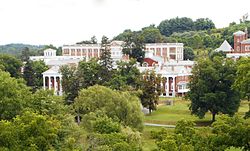
The Metropolitan State Hospital was an American public hospital for the mentally ill, on grounds that extended across parts of Waltham, Lexington, and Belmont, Massachusetts. Founded in 1927, it was at one time the largest and most modern facility of its type in Massachusetts. It was closed in January 1992 as a result of the state's cost-cutting policy of closing its mental hospitals and moving patients into private and community-based settings. The main complex of buildings has subsequently been redeveloped into apartments. The hospital campus was listed on the National Register of Historic Places 1994. The property also housed the Gaebler Children's Center for mentally ill youth.

Staunton is an independent city in the U.S. Commonwealth of Virginia. As of the 2020 census, the population was 25,750. In Virginia, independent cities are separate jurisdictions from the counties that surround them, so the government offices of Augusta County are in Verona, which is contiguous to Staunton. Staunton is a principal city of the Staunton-Waynesboro Metropolitan Statistical Area, which had a 2010 population of 118,502. Staunton is known for being the birthplace of Woodrow Wilson, the 28th U.S. president, and as the home of Mary Baldwin University, historically a women's college. The city is also home to Stuart Hall, a private co-ed preparatory school, as well as the Virginia School for the Deaf and Blind. It was the first city in the United States with a fully defined city manager system.

In 1924, the Virginia General Assembly enacted the Racial Integrity Act. The act reinforced racial segregation by prohibiting interracial marriage and classifying as "white" a person "who has no trace whatsoever of any blood other than Caucasian." The act, an outgrowth of eugenist and scientific racist propaganda, was pushed by Walter Plecker, a white supremacist and eugenist who held the post of registrar of Virginia Bureau of Vital Statistics.

Joseph Spencer DeJarnette was the director of Western State Hospital from 1905 to November 15, 1943. He was a vocal proponent of racial segregation and eugenics, specifically, the compulsory sterilization of the mentally ill.

The Trans-Allegheny Lunatic Asylum, subsequently the Weston State Hospital, was a Kirkbride psychiatric hospital that was operated from 1864 until 1994 by the government of the U.S. state of West Virginia, in the city of Weston. Weston State Hospital got its name in 1913 which was used while patients occupied it, but was changed back to its originally commissioned, unused name, the Trans-Allegheny Lunatic Asylum, after being reopened as a tourist attraction.
The Commonwealth Center for Children and Adolescents, formerly known as The DeJarnette Center for Human Development, is a children's mental hospital located in the city of Staunton, Virginia, in the United States.

The South Carolina State Hospital is a publicly funded state-run psychiatric hospital in Columbia, South Carolina. Founded in 1821 as the South Carolina Lunatic Asylum, it was one of the first public mental hospitals established in the United States. The Mills Building, its first building, was designed by early American architect Robert Mills, and is a National Historic Landmark. The hospital had more than 1,000 patients in 1900, but with the transition of mental health facilities to community settings, it is now much smaller, occupying a small portion of its campus, with other parts housing offices and facilities of the state's Department of Mental Health.

Broughton Hospital is a psychiatric hospital located in Morganton, North Carolina. It is administered by North Carolina Department of Health and Human Services Division of Mental Health, Developmental Disabilities and Substance Abuse Services.

Staunton River State Park is a state park in Virginia. One of the Commonwealth's original state parks, built by the Civilian Conservation Corps and opening in 1936, it is located along the Staunton River near Scottsburg, Virginia. It is an International Dark Sky Park.
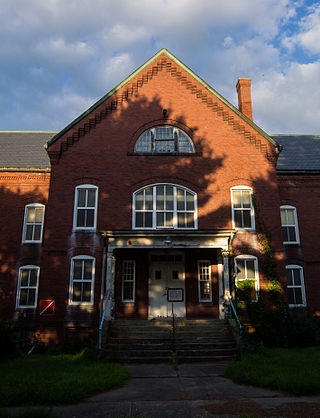
Medfield State Hospital, originally the Medfield Insane Asylum, is a historic former psychiatric hospital complex at 45 Hospital Road in Medfield, Massachusetts, United States. The asylum was established in 1892 as the state's first facility for dealing with chronic mental patients. The college-like campus was designed by William Pitt Wentworth and developed between 1896 and 1914. After an era dominated by asylums built using the Kirkbride Plan, Medfield Insane Asylum was the first asylum built using the new Cottage Plan layout, where instead of holding patients in cells, they would be integrated into a small community and work a specific job. It was formally renamed "Medfield State Hospital" in 1914.
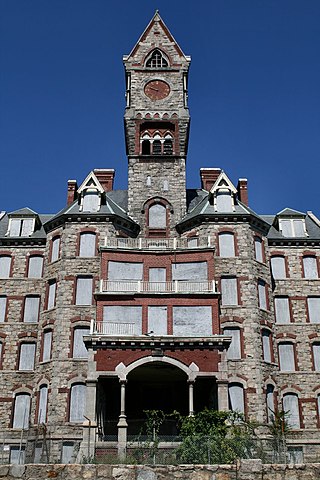
Worcester State Hospital was a Massachusetts state mental hospital located in Worcester, Massachusetts. It is credited to the architectural firm of Weston & Rand. The hospital and surrounding associated historic structures are listed as Worcester Asylum and related buildings on the National Register of Historic Places.

Central State Hospital, originally known as the Central Lunatic Asylum, is a psychiatric hospital in Petersburg, Virginia, United States. It was the first institution in the country for "colored persons of unsound mind".
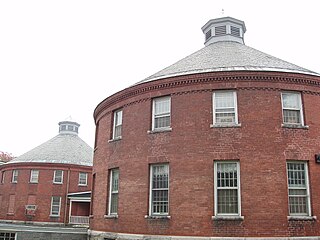
Vermont State Hospital, alternately known as the Vermont State Asylum for the Insane and the Waterbury Asylum, was a mental institution built in 1890 in Waterbury, Vermont to help relieve overcrowding at the privately run Vermont Asylum for the Insane in Brattleboro, Vermont, now known as the Brattleboro Retreat. Originally intended to treat the criminally insane, the hospital eventually took in patients with a wide variety of problems, including mild to severe mental disabilities, epilepsy, depression, alcoholism and senility. The hospital campus, much of which now houses other state offices, was listed on the National Register of Historic Places in 2016. Partly as a replacement for this facility, the state currently operates the 25 bed Vermont psychiatric care hospital in Berlin, VT.

Salem Veteran Affairs Medical Center (VAMC) is one of the largest VA hospitals located at 1970 Roanoke Blvd. Salem, Virginia 24153. Since 1934 VAMC in Salem has been improving the health of the men and women who have so proudly served the United States Navy, United States Army, United States Air Force, United States Coast Guard and United States Marines. Health care services have been provided to more than 112,500 veterans living in a 26-county area of southwestern Virginia. Salem VAMC provided community-based outpatient clinics. In addition to the main facility in Salem, there are affiliated services in three community-based outpatient clinics. These clinics are located in Danville, Virginia, Lynchburg, Virginia, Tazewell, Virginia, Wytheville, Virginia, and Staunton, Virginia.

The Virginia State Colony for the Epileptics and Feeble Minded was a state run institution for those considered to be “Feeble minded” or those with severe mental impairment. The colony opened in 1910 near Lynchburg, Virginia in Madison Heights with the goal of isolating those with mental disabilities and other qualities deemed unfit for reproduction away from society. The colony was the home of Carrie Buck, the subject of the landmark Supreme Court case Buck v. Bell.

Napa State Hospital is a psychiatric hospital in Napa, California, founded in 1875. It is located along California State Route 221, the Napa-Vallejo Highway, and is one of California's five state hospitals. Napa State Hospital holds civil and forensic patients in a sprawling 138-acre campus. According to a hospital spokesperson, there were 2,338 people employed at the facility during the 2016 to 2017 fiscal year, making it one of the region's largest employers.
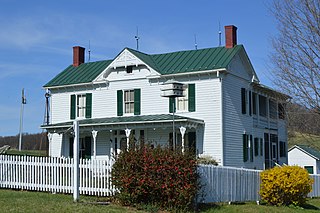
Maple Front Farm, also known as Locust Front Farm and W. K. Clemmer Farm, is a historic home and farm complex located near Middlebrook, Augusta County, Virginia. The house was built about 1900, and is a two-story, three bay, frame I-house. Also on the property are a contributing washhouse, meat house, wood house, acetylene gas-generating structure, farm bell tower, garage, and granary.

Homestead Dairy Barns, also known as Miller Mill and Inn at Gristmill Square, is a historic dairy barn complex and national historic district located at Warm Springs, Bath County, Virginia, USA. The district encompasses seven contributing buildings. The complex consists of the Main Barn with its attached tile double silos, a Bottling Building, Milking Barn, Calving Barn, Ham House, Herdsman's Cottage, and Bull Barn. The complex was built by the Virginia Hot Springs Company in 1928 to support the operations of the nearby Homestead resort. They are frame buildings, many of which are clad in stucco and painted white with unifying green trim. They include repetition of Colonial Revival and Craftsman details throughout.

Janney House, also known as Morrison House and Janney Hill, is a historic home located at Hamilton, Loudoun County, Virginia. It was built in 1876, and is a 2+1⁄2-story, five bay, wood frame I-house in the Late Victorian style. It sits on a stone foundation and has a standing seam metal side gable roof. It features a one-story, wraparound porch. Also on the property is a contributing combination garage and stable building.
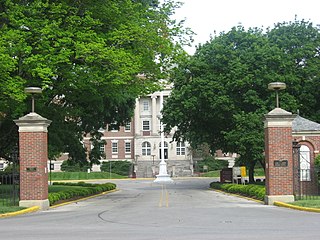
Indianapolis Veterans Administration Hospital, also known as Larue D. Carter Memorial Hospital is a historic hospital complex and national historic district located at Indianapolis, Indiana. The district resources were developed between 1930 and 1951 by the Veterans Administration, and encompasses 15 contributing buildings, 2 contributing sites, 2 contributing structures and 5 contributing objects on the hospital campus. The main complex is connected by an enclosed corridor and consists of the main hospital building (1931), kitchen/mess hall/boiler house/attendants' quarters, general medical building (1939), and recreation building (1941). The buildings reflect the Colonial Revival and Classical Revival styles of architecture.

